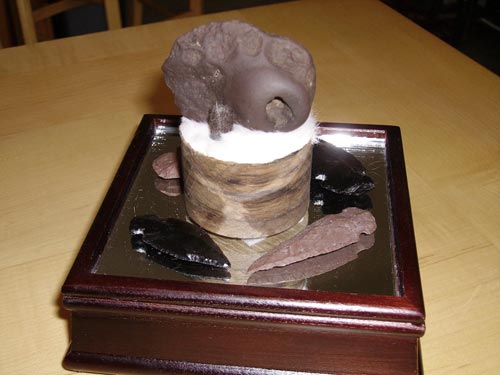Musical instruments from pre-Columbian times
Scientists were stunned by the discovery of a human skeleton buried in an Aztec temple with a clay skull whistle in each hand.
After nearly 15 years of sleeping peacefully, until someone blew the whistle, the shrieking sound of it made other people cold in the spine. If death has sound, this is it.
Roberto Velazquez believed that the Aztecs created a mournful cry from the Death Whistle before they were sacrificed to the gods.
The 66-year-old mechanical engineer has devoted his career to creating the sound of his pre-Columbus ancestors, producing hundreds of copies of horns, flutes and wind instruments beneath the ruins of Mexico.
For many years, many archaeologists who discovered sound creation tools considered them as toys. Museums put them in warehouses. While ancient cultural studies and exhibitions focus on their shape, Velazquez says the sound creation tool provides new ideas for studying their sound.
'We studied ancient culture as if they were dumb and deaf. But I think all of this is closely related to what they do, how they think. '
Velazquez is currently involved in a field of research including archaeologists, musicians and historians. Doctors are also interested in believing that the Aztecs can use sounds to heal.
Sounding tools made of clay, turkey feathers, sugar cane, frog skins and natural materials that are part of pre-Columbian life are discovered almost in every Maya area. The Aztecs produced a low-pitched sound with conch shells at the beginning of the ceremony and could be during the war to convey tactics. Hunters can use animal-shaped ocarina horns to create growls to lure deer.

Copies of a clay whistle from pre-Columbian times.(Photo: blogspot.com)
Archaeologists today, who think of the name of Death Whistle, believe that they are made to help the journey of the dead to the afterlife, while the tribes are thought to make sounds. Scary bar to scare off enemies, like today's tech crowd control devices.
Experts believe that pre-Columbian tribes used a number of instruments to put the human brain into a dreamy state and cure some diseases. Ancient horns can guide research into how rhythmic sounds change people's heartbeat and alertness. Amidst the Velazquez replicas, the tools made such a strange shrill sound that their frequency was close to the maximum hearing threshold of human hearing.
The chronicle of Spanish monks since the 1500s describes Aztec and Maya sounds with a sad, plaintive sound, although these may be the only instruments they hear. According to Arnd Adje Both, a pre-Spanish archaeologist, the first person to blow into the Death Whistle in the hand of the Aztec remains: 'My experience is that at least some pre-Spanish sounds sound More destructive than positive, other sounds suggest a coma. Certainly the sound is used in all kinds of heretics, like human sacrifices, but also in healing rituals. '
Sound also plays an important role in Mexican society. A bell rang signaling that the garbage truck arrived outside the households in Mexico City. The non-tone flute is the knife sharpener. A whistle imitating the cat's voice called the lottery seller right in front of the door. But pre-Columbian musical instruments often lie in warehouses. 'I'm talking about museums all over the world, not just here.'
According to Tomas Barrientos, director of the Archeology Department of Del Valle, Guatemala, that is changing. 'Nobody knows about this 10 years ago. But when museums and private collections are being published, this field of research is increasingly important. '
Velaquez carefully studied each sound generator before making a copy of it. He traveled throughout Mexico to examine newly unearthed wind instruments, some dating back to 400 BC and shaped like animals or gods. He studied sculptures and traces in 500-year-old Spanish chronicles.
But making copies is only part of the job. Then he had to figure out how to play them. He blows in a few holes and blocks other holes, or presses the instrument on his lips and vibrates his tongue. Sometimes he put a sound creation tool in his mouth and blew, adjusting the air from his lungs.
He experimented with a frog-shaped whistle for a year before discovering its buzzing sound.
'Some of the instruments we discovered were broken, which is great because we can see the internal structure, the real technology to build a sound compartment from paper-thin clay.'
However, their exact sound is still a mystery.
'When you blow at them, you can still get a few notes, so you can visualize their range. But we don't have a record board to get the correct sound. '
- Found ancient Chinese musical instruments
- Learning musical instruments is good for the child's nerves
- Telemetron - Musical instruments are designed to play in a zero gravity environment
- Ancient instruments still play well after 1,700 years
- Without instruments, humans can create music with eye movement
- The world's oldest musical instrument is revealed
- AI can separate the musical instrument from the video just in
- Video: Flying robots play musical instruments
- 5 inventions are said to be involved in
- Do you have the potential of
- High tech ink from graphene
- The risk of infection when sharing steam instruments
 Discovered an ancient centipede fossil 99 million years old
Discovered an ancient centipede fossil 99 million years old Discovered bat-like dinosaurs in China
Discovered bat-like dinosaurs in China Discovered a 200-year-old bronze cannon of the coast
Discovered a 200-year-old bronze cannon of the coast Discover 305 million-year-old spider fossils
Discover 305 million-year-old spider fossils